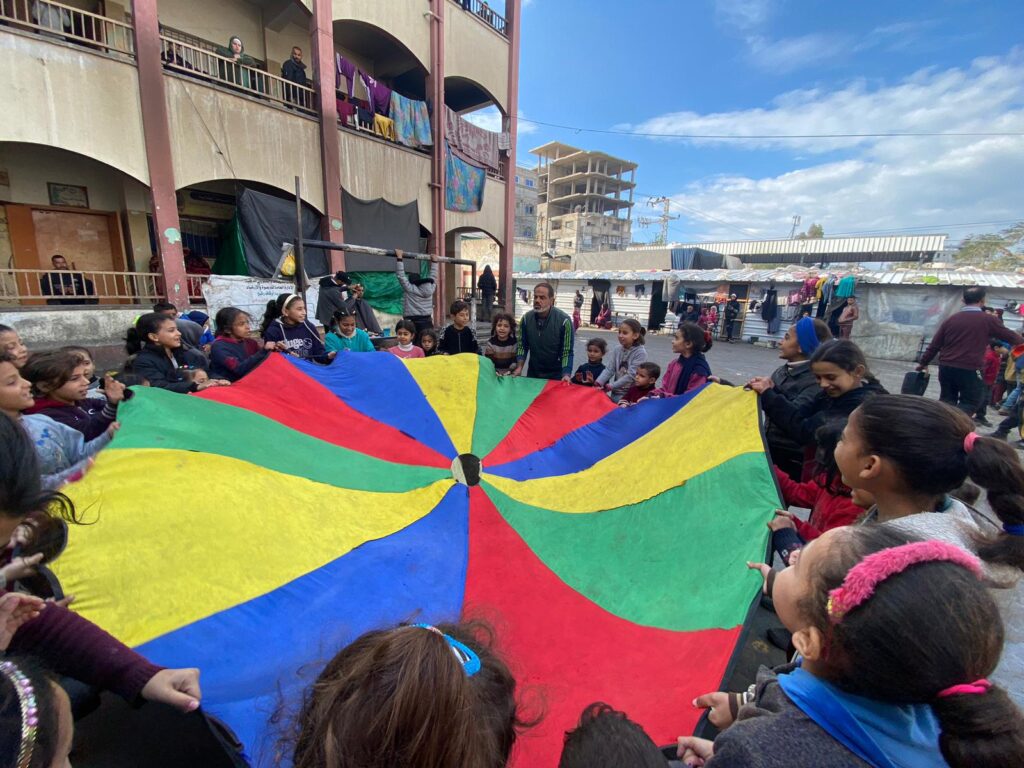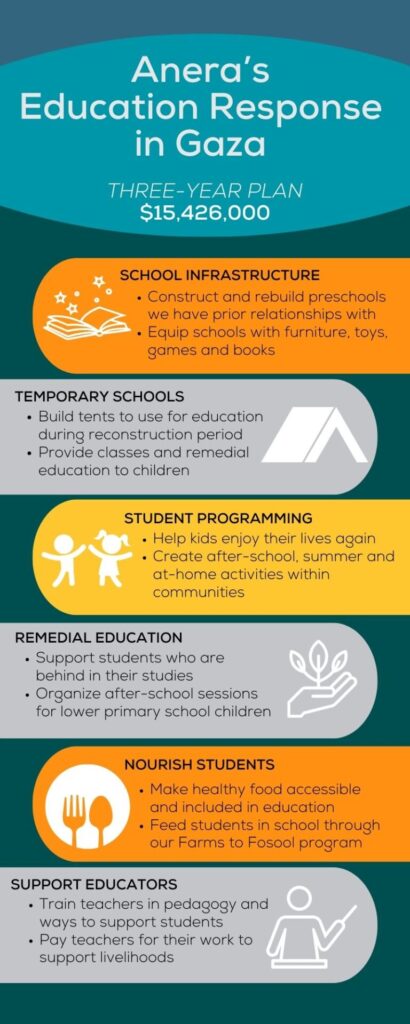Education is Under Attack in Gaza
Posted in: News
Part of a series on the impact of the war on all sectors of economic life within Gaza, Anera’s immediate response and plans for the future. Other posts cover livelihoods, housing, WASH, health and food production systems.
- “The longer children stay out of school, the more difficult it is to catch up, with lasting consequences.” — UNRWA
- A total of 162 school buildings in Gaza have been directly hit by the Israeli Army. This accounts for approximately 28.8% of all school structures that previously served around 175,000 students and employed more than 6,500 teachers. — UN
- A new term has arisen amid the devastation in Gaza this January: “scholasticide,” referring to the deliberate destruction by Israeli forces of educational institutions cherished by Palestinian society. This includes the bombing of the Ministry of Education, the obliteration of teaching infrastructure, and the targeting of schools across the Gaza Strip through air, sea, and ground attacks. — The Guardian
The Gaza Strip, covering an area of 365 square kilometers, is home to a population of 2.3 million people, making it one of the most densely populated regions globally, with approximately 5,900 residents per square kilometer.
Since October 7, 2023, Gaza has been gripped by unprecedented violence and mass displacement, leaving students without access to education for six months. Evacuation orders, movement restrictions, civilian casualties, and the killing of educators and students have worsened the situation. Many schools now serve as shelters for displaced families, exposing children to harsh living conditions that make learning impossible. In addition to material challenges, the psychological trauma these children endure further hinders their education.
A 17-year blockade and periodic wars in Gaza had significantly damaged an already fragile education system, straining facilities, disrupting education, and negatively impacting the well-being of children and teachers. Before October, Gaza’s K-12 education system served 625,000 students and 22,564 teachers across 813 schools in 563 buildings, with 63% of schools sharing facilities and operating on a “double-shifting” schedule.
Palestinians stand out as one of the most educated populations in the Middle East. Despite enduring substantial challenges, students in Gaza consistently demonstrated top academic performance within the Palestinian territories.
As of the end of January, the Education Cluster, part of the United Nations humanitarian coordination forum, reported extensive damage to Gaza’s school infrastructure, with 386 school buildings affected, representing over 78% of all school structures. This included 25 schools destroyed, 113 severely damaged, 125 moderately damaged, and 123 with minor damage. Among these, 61% of governmental school buildings, 44% of UNRWA school buildings, and 44% of private school buildings were either directly hit or damaged. Currently, about 90% of school structures in Gaza are being used as shelters for internally displaced persons, with 142 of them either directly hit or damaged.
The Israeli military’s actions have disrupted the education and safety of 625,000 students and 22,564 teachers in Gaza, resulting in thousands of casualties among the nearly 32,000 people killed to date. Of the 378 schools affected, constituting 76% of all school buildings, 117 suffered severe damage or destruction. Around 433,000 children and 16,200 teachers were impacted.
Approximately 55% of Gaza’s schools require complete reconstruction or significant rehabilitation to reopen.
The Khan Younis, North, and Gaza City governorates have been hit hardest, accounting for three-quarters of all damaged schools. Some schools, though not completely destroyed, have been stripped of furniture and textbooks, with desperate individuals burning them due to fuel shortages. Even seeking refuge in school buildings hasn’t spared lives, with at least 340 internally displaced persons losing their lives and over 1,100 sustaining injuries in UNRWA shelters, violating international law.
The hostilities have killed more than 10,000 children in Gaza. As of February 27, UNOCHA estimated that the Israeli military operations in the Gaza Strip killed 5,379 students and 255 educators and injured another 8,888 students and 891 teachers.
The Israeli attacks have been even more devastating on Gaza’s higher education system, destroying or damaging all 12 of Gaza’s universities. Israeli forces also killed 100 academics.
Upon displacing 1.9 of Gaza’s 2.3 population, safety remains elusive as schools acting as shelters face constant threats of bombing, siege, sniper fire, and explosions. Amidst the uproar of war, makeshift learning centers and mobile education initiatives provide potential opportunities for children to continue their studies and maintain a sense of normalcy. At the same time, education does not receive enough attention due to the pressing health, shelter, and food security needs. As of March 2nd, the education response faced a considerable shortfall in funding, having received less than 15% of the necessary resources.
Anera’s Rapid Response to Education Needs in Gaza
In overcrowded shelters, the absence of structured education and psychosocial services hinders children’s social and mental wellbeing and development. Anera’s team is currently observing many adverse effects on children as they endure prolonged stays in unfamiliar and terrifying environments, emphasizing the need for timely child protection interventions such as psychosocial support services.
To combat stress and support children’s psychosocial and educational development, Anera has implemented psychosocial support and targeted educational programming throughout schools and shelters in Gaza, with services led by trained activity leaders, psychologists, and social work counselors. Since the start of the war, Anera’s staff on the ground has conducted over 130 psychosocial support activities in school and informal shelters, where thousands of children participate in arts and crafts, storytelling, music, face painting, races, and games.


Anera’s Longer-term Response in Gaza’s Education Sector
With our long-standing dedication to fostering early education, providing training opportunities for youth, and ensuring an effective learning environment for educators, Anera acknowledges the significant challenges faced by the children of Gaza today. These challenges stem from the trauma they endure and the disruption of their everyday routines in recent months.
To provide essential experiences for children’s development, Anera aims to reconstruct learning spaces and support educators who nurture and guide them. As part of our recovery efforts, Anera will focus on rebuilding and repairing damaged schools and providing training and resources to teachers and communities to support children year-round, including during the school year, summer, and out-of-school periods.
Anera is allocating $15,426,000 for Education interventions, as detailed below:
- Construction and rehabilitation of schools, including temporary spaces for instruction, at $11,232,000
- After-school, summer, and at-home programs, at $2,286,000
- Training teachers in pedagogy and student support and paying teachers in cases where schools cannot, at $1,908,000
- Feeding students in schools through our Farms to Fosool program, at $3,210,000


OUR BLOG
Related
Anera’s trainees had an amazing experience at the Maroun Chedid Academy during a recently ended pasta-making workshop as part of our hospitality training. From mastering the perfect dough to creating delicious sauces, they refined their culinary skills and prepared for…

